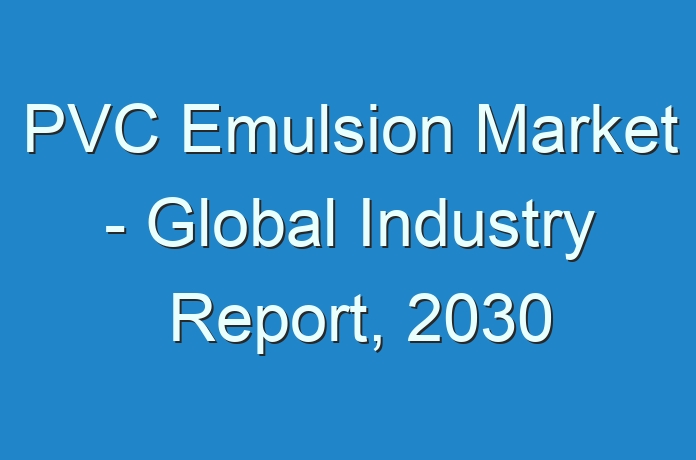
PVC Emulsion Market: Introduction
Transparency Market Research delivers key insights on the global PVC emulsion market. In terms of revenue, the global PVC emulsion market is estimated to expand at a CAGR of ~4% during the forecast period, owing to numerous factors regarding which TMR offers thorough insights and forecasts in its report on the global PVC emulsion market.
The global PVC emulsion market is broadly affected by several factors such as import-export data of flooring & wall covering, PVC production by region, synthetic leather production, construction industry growth, and GDP growth of respective countries considered in the study. Thus, rise in application of PVC emulsion in different sectors is propelling the global PVC emulsion market. Furthermore, we have excluded micro-suspension-based PVC emulsion from the scope of our study. The market studied is purely for emulsion-based PVC.
Download PDF Brochure – https://www.transparencymarketresearch.com/sample/sample.php?flag=B&rep_id=80443
PVC Emulsion Market: Dynamics
PVC resin produced by the emulsion polymerization process is known as PVC emulsion/emulsion grade PVC or paste PVC. Emulsion polymerization is a form of polymerization that occurs in an emulsion. Emulsion polymerization is the second-most used polymerization technique. It produces PVC grains, which are 100 times smaller (0.1-3.0 µm) than suspension PVC grain. Around 10% of the PVC resin across the globe is produced by the emulsion polymerization process.
Emulsion grade PVC/ paste grade PVC is primarily used in manufacture of plastisol. Manufacture of PVC emulsion entails much more energy and cost than suspension resin. Essential components involved in emulsion polymerization of PVC include water, VCM (vinyl chloride monomer), catalyst (water soluble peroxidase and persulfates), and surfactants (alkyl sulfates, alkyl sulfonates, alkylbenzenesulfonates, dialkyl sulfosuccinates, alkyl ethoxysulfates, fatty acid soaps, etc.)
More Trending Reports by Transparency Market Research – https://www.prnewswire.com/news-releases/increasing-rubber-recycling-rate-to-create-opportunities-in-industrial-rubber-products-market-from-2019-to-2027-tmr-study-301123822.html
PVC Emulsion Market: Prominent Regions
Asia Pacific dominated the global PVC emulsion market with more than 40% share in 2019. This trend is anticipated to continue during the forecast period. The rise in demand for PVC emulsion in the formulation of synthetic leather is likely to drive the PVC emulsion market in the near future. Synthetic leather is used in buses, trucks, cars, and motorcycles, as it is highly elastic, comfortable, and resistant to high as well as low temperatures. Automotive vehicle owners are investing significantly in synthetic leather interiors to enhance the appearance of their cars as well as their driving experience. Traditional leather is expensive to use as automotive interiors. Significant amount of leather is used in automotive interior. The consumption of PVC emulsion is primarily based on production of automotive vehicles. PVC emulsion-based synthetic leather is also used in the footwear industry, owing to its wear-resistant property and soft texture. Rise in disposable income, wide range of applications, and low price of PVC emulsion-based leather products compared to its alternatives are likely to propel the PVC emulsion market in Asia Pacific.
Ask for Discount on Premium Research Report With Complete TOC at – https://www.transparencymarketresearch.com/sample/sample.php?flag=D&rep_id=80443
PVC Emulsion Market: Key Players
The global PVC emulsion market was highly consolidated in 2019. The top four players — Vinnolit GmbH & Co. KG, VESTOLIT GmbH (Mexichem), Kem One, and LG Chem — cumulatively accounted for more than 40% share of the global PVC emulsion market in the year.
Vinnolit GmbH & Co KG is a subsidiary of the Westlake Group, which is one of the largest manufacturers of PVC in Europe. The company has six production facilities located in Gendorf, Burghausen, Cologne, Knapsack, and Schkopau in Germany; and Hillhouse in the U.K. The company possesses combined annual capacity of 780,000 tons of PVC, including emulsion grade and suspension grade PVC. Additionally, it produces 665,000 tons of vinyl chloride monomer (VCM) and 475,000 tons of membrane-grade caustic soda per annum.
Request for covid19 Impact Analysis – https://www.transparencymarketresearch.com/sample/sample.php?flag=covid19&rep_id=80443





